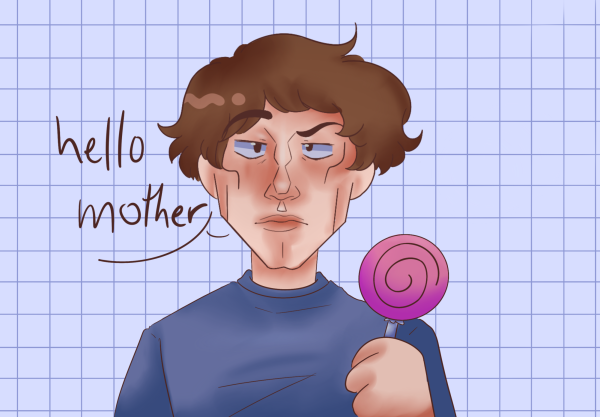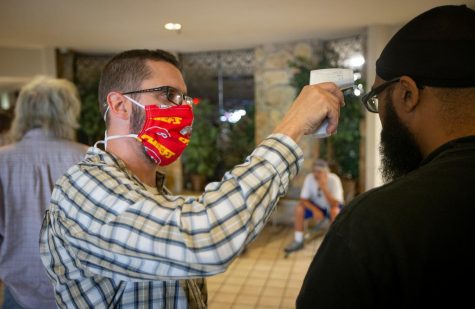Sculpture defacing detracts from dialogue
“Tres Mujeres Caminando,” a statue of three women located outside the Rhatigan Student Center, across from Grace Memorial Chapel, were discovered to have duct tape on the mouths. Ulrich Museum of Art preparators removed the duct tape Thursday morning.
Art and activism don’t have to be at odds with each other. In fact, many artists routinely use their work to bring about awareness and advocate for social change.
That’s not what’s happening at Wichita State.
The duct tape that briefly covered the mouths of 11 female figures in outdoor sculptures at Wichita State last week was not a meticulously placed artistic touch, but a destructive distraction from meaningful dialogue.
No one has claimed responsibility for the duct tape, or, for that matter, the fliers plastering Robert Indiana’s “LOVE” sculpture that depict the now-infamous image of two Phi Delta Theta members hanging a banner with the words “New Members … Free House Tours,” but it’s clear that vandalizing sculptures has become a means of making social commentaries on campus.
This expression isn’t without consequences. The duct tape, which left a residue on the artwork that will necessitate careful removal, could cause Wichita State to install expensive security cameras or even move pieces from the outdoor sculpture collection indoors.
Activism is supposed to get people’s attention. It can be disruptive. But it shouldn’t be destructive.
There’s no way to conclusively say what the vandalism was intended to signify, but duct taped mouths are widely understood to represent a sense of being silenced and devalued.
If activists did in fact mean to call attention to the plight of sexual abuse victims who feel marginalized and silenced, they could have gone about it in a much more productive manner.
Fliers around campus can be informative. Duct tape covering the mouths of willing participants can provide a powerful social commentary about oppression.
Vandalizing sculptures certainly got people’s attention, but not for the right reasons.
It has started a conversation about defacing artwork, that detracts from the important dialogue about sexual baiting that the Wichita State community should be engaged in after the banner incident.
Well-intentioned or otherwise, no one is above reproach when it comes to vandalism.
Sculptures are in no way more important than victims of sexual abuse. They’re just a distraction.
The sooner conversations about sculpture defacing can be put to rest, the sooner a productive dialogue can be reopened.

Matthew Kelly is a former editor-in-chief and managing editor for The Sunflower. Kelly graduated in 2020 with a bachelor’s degree in political science...



















JT • Sep 21, 2017 at 1:53 pm
What’s really destructive, unlike the activism and movement attacked here by the writer, is this piece’s narrow, self-righteous viewpoint. This is an opinion piece, I concede, but apparently the definition this writer has of “opinion” is his ideas being the one and only way to perceive subjective concepts like art, forms of activism, and methods to advocate for a cause, while making no points to address the other side’s view of the situation. So let’s address the the points made here by the author, a courtesy his “opinion” piece lacked.
He makes, essentially, three points as to why this act was destructive and inefficient: (1) the cost of removing tape residue, (2) the cost of possibly installed security cameras and (3) the need to explore alternative means of activism. First, the author does not state any actual cost of the “damage” done to the art. Apparently, the difficult task of the “careful removal” of tape residue is one part of the excessive cost of this act. In a former article assessing the removal process, wiping it down with mineral solution was determined as the product needed to remedy this “harm.” Mineral spirit cleaning solution is $20. Even presuming the writer makes another argument on the cost of the diminished value of the artwork resulting from the tape, these pieces of art are designed to be outside, to face rain, snow, hail, minute chemicals found in rain, erosive chemicals found in bird droppings, or a squirrel gnawing on them. Any damage these works of art have already faced in Kansas weather have already depreciated their “value” such that tape would not make any difference. Further, the resale value of these pieces is irrelevant, as WSU is unlikely planning to sell them anytime soon and the value of these pieces comes in what they represent artistically, not their price tag. This is not taking a sledgehammer to the face of these statues. It’s literally just duct tape.
Second, the university’s claim to set up security cameras is an action that the writer himself should dismiss based on his argument against the act of activism. If the writer’s premise is to say that dialogue, and not acts, are the solution to problems of sexual abuse, then the school should save their money on cameras and invest in programs, infrastructure, and training designed to inform, educate, and prevent sexual abuse and rape. If these societal problems are the catalyst to the the “vandalism”, then the remedy, not only to prevent this form of activism but to address the actual problem that the university should addressing in the first place, than the cost of the security cameras is not the fault of the group consistently ignored, but of the university for ignoring their pleas. It’s easy to say their is a choice and that the activist group could have went another way about doing things, but if that is claimed, the same can be said for the school. But that takes me to my third point.
Finally, the author argues for alternatives means of activism that do not result in the inexpensive cost of removing tape and the vague threats of installing cameras on the university’s dime (the students’ dime). Specifically, he offers putting up flyers as a “productive” form of activism. What the writer does not say is whether the flyers can make people care, change, or even begin a dialogue. How many people’s perspective are suddenly changed by a flyer? How many people even stop to read a flyer that blends in to all the other flyers that promote college coupons, student loan advertisements, and funny comic strip cut outs? What the author implies by citing flyers as the hook that will get the discussion on sexual abuse and violence started (and please correct me if I’m wrong), is that messages should be delivered in a single, sterile form. Art translates more messages, and arguably more powerfully, than facts sheets. Books are read to create empathy and make a connection to readers through a narrative in order to teach a lesson, critique society, comment on a human condition. Art does the same through imagery and interpretation. These forms are powerful because they grasp the attention of an individual and makes them think to reach a conclusion on their own, relate their own experiences, and making a connection. Activism can take the form of novels, art, film, or television, to relate their message in a way that simple facts cannot. Some form of artistic activism, or even art in general, may be controversial in order to increase attention and concern. Admittedly, I am here writing this because the title of this piece was controversial to me. Presumably, the writer wrote this opinion piece which at least refers to sexual abuse because this act of activism was controversial to him. The activism did its job: the writer wrote about it. It was his decision, though, to write about his beliefs on act instead of the issue that prompted it. But note that the writer didn’t write about a flyer. Even if this article isn’t about the rampant sexual abuse left unaddressed by the university, it is clear that the article is about what the writer feels sexual abuse is or is not worth doing. That, in itself, is a good indication of how people like the writer disregard the issue, and deflect by shaming and attacking the form by which the issue was brought to them.
This act was harmless (see points 1 and 2 above) and sent a powerful message at the same time. These issues are not new; there have been seminars, informational meetings, flyers, and mandatory surveys. These methods have been inadequate and the students need more. The students went through formal channels and less controversial methods to have the university address these issues but resulted in no action. They made a more powerful message, and now people are talking. Addressing sexual abuse is more than the $20 cost of a bottle of cleaner. Addressing sexual abuse is worth more than the cost of any needless security cameras. The lives and safety of any person from is not worth wasting resources and leaving the student body vulnerable by continuing fruitless attempts to get the university or student body to address the issue of sexual abuse through flyers.
Chrys • Sep 19, 2017 at 3:27 pm
What dialogue has there been? At best, we talk about sexual assault long after it happens and at a distance. The university has said more negative things students calling attention to problems than they’ve actually spent talking about the problems. Putting up security cameras to protect sculptures? What about putting more into protecting victims of sexual assault. Damage that happened to the sculptures sucks, but the response has been overkill. Way to focus on inanimate objects but barely discuss assault, harassment, and rape.
anon • Sep 18, 2017 at 4:24 pm
I thought the fliers on the Love statue were claimed by the self proclaimed organization “We The Students”?